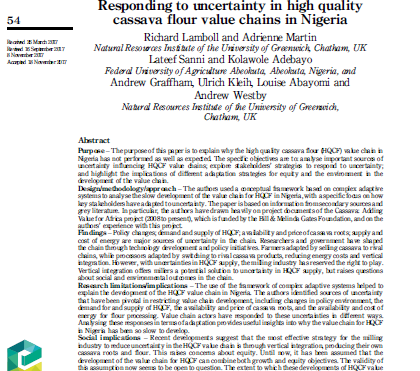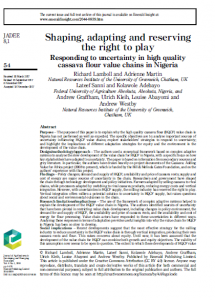This paper aims to explain why the high quality cassava flour (HQCF) value chain in Nigeria has not performed as well as expected. The specific objectives are to: analyse important sources of uncertainty influencing HQCF value chains; explore stakeholders’ strategies to respond to uncertainty; and highlight the implications of different adaptation strategies for equity and the environment in the development of the value chain.
The authors used a conceptual framework based on complex adaptive systems to analyse the slow development of the value chain for HQCF in Nigeria, with a specific focus on how key stakeholders have adapted to uncertainty. The paper is based on information from secondary sources and grey literature. In particular, the authors have drawn heavily on project documents of the Cassava: Adding Value for Africa project (2008 to present), which is funded by the Bill & Melinda Gates Foundation, and on the authors’ experience with this project.
Policy changes, demand and supply of HQCF, availability and price of cassava roots, and supply and cost of energy are major sources of uncertainty in the chain. Researchers and government have shaped the chain through technology development and policy initiatives. Farmers adapted by selling cassava to rival chains, while processors adapted by switching to rival cassava products, reducing energy costs and vertical integration. However, with uncertainties in HQCF supply, the milling industry has reserved the right to play. Vertical integration offers millers a potential solution to uncertainty in HQCF supply, but raises questions about social and environmental outcomes in the chain.
Region: Nigeria
Date published:
2017
Published by:
Journal of Agribusiness in Developing and Emerging Economies
Type of resource:
Journal article
Resource topic:
Cassava
Project/Programme: Not specific
Pest/Disease: Not specific
Pages:
24
File type:
External link (436 KB)




